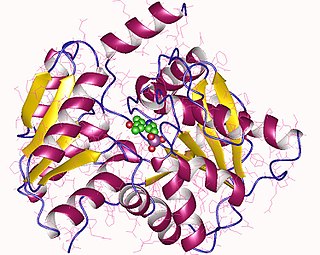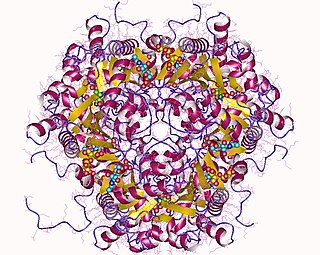
Nucleotides are organic molecules composed of a nitrogenous base, a pentose sugar and a phosphate. They serve as monomeric units of the nucleic acid polymers – deoxyribonucleic acid (DNA) and ribonucleic acid (RNA), both of which are essential biomolecules within all life-forms on Earth. Nucleotides are obtained in the diet and are also synthesized from common nutrients by the liver.

Nucleic acid metabolism is a collective term that refers to the variety of chemical reactions by which nucleic acids are either synthesized or degraded. Nucleic acids are polymers made up of a variety of monomers called nucleotides. Nucleotide synthesis is an anabolic mechanism generally involving the chemical reaction of phosphate, pentose sugar, and a nitrogenous base. Degradation of nucleic acids is a catabolic reaction and the resulting parts of the nucleotides or nucleobases can be salvaged to recreate new nucleotides. Both synthesis and degradation reactions require multiple enzymes to facilitate the event. Defects or deficiencies in these enzymes can lead to a variety of diseases.

Deoxyuridine monophosphate (dUMP), also known as deoxyuridylic acid or deoxyuridylate in its conjugate acid and conjugate base forms, respectively, is a deoxynucleotide.
The enzyme carbamoyl-serine ammonia-lyase (EC 4.3.1.13) catalyzes the chemical reaction

The enzyme L-serine ammonia-lyase (EC 4.3.1.17) catalyzes the chemical reaction
In enzymology, a 1-aminocyclopropane-1-carboxylate deaminase (EC 3.5.99.7) is an enzyme that catalyzes the chemical reaction
In enzymology, 2-aminomuconate deaminase (EC 3.5.99.5) (also known as amnd) is an enzyme that catalyzes the chemical reaction

In enzymology, an adenine deaminase (EC 3.5.4.2) is an enzyme that catalyzes the chemical reaction
In enzymology, an adenosine-phosphate deaminase (EC 3.5.4.17) is an enzyme that catalyzes the chemical reaction
In enzymology, an ADP deaminase (EC 3.5.4.7) is an enzyme that catalyzes the chemical reaction
In enzymology, an ATP deaminase (EC 3.5.4.18) is an enzyme that catalyzes the chemical reaction
In enzymology, a blasticidin-S deaminase (EC 3.5.4.23) is an enzyme that catalyzes the chemical reaction
In enzymology, a cytosine deaminase (EC 3.5.4.1) is an enzyme that catalyzes the chemical reaction
In enzymology, a dCTP deaminase (EC 3.5.4.13) is an enzyme that catalyzes the chemical reaction
In enzymology, a deoxycytidine deaminase (EC 3.5.4.5) is an enzyme that catalyzes the chemical reaction

In enzymology, a glucosamine-6-phosphate deaminase (EC 3.5.99.6) is an enzyme that catalyzes the chemical reaction
In enzymology, a guanosine deaminase (EC 3.5.4.15) is an enzyme that catalyzes the chemical reaction
In enzymology, a pterin deaminase (EC 3.5.4.11) is an enzyme that catalyzes the chemical reaction
In enzymology, a S-adenosylhomocysteine deaminase (EC 3.5.4.28) is an enzyme that catalyzes the chemical reaction
In enzymology, a sepiapterin deaminase (EC 3.5.4.24) is an enzyme that catalyzes the chemical reaction






